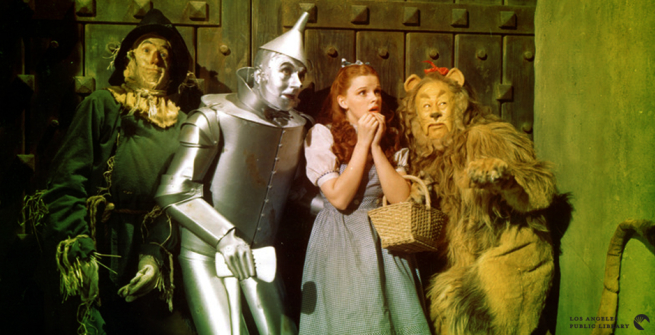Once upon a time in Hollywoodland, 80 years ago today, The Wizard of Oz had its Hollywood Premiere at Grauman’s Chinese Theater.

On August 15, 1939, the blockbuster film version of L. Frank Baum’s children’s classic The Wizard of Oz, originally titled by Baum The Wonderful Wizard of Oz in 1900, had its Hollywood premiere at Grauman’s Chinese Theater. (A few days previously it had sneak peeks and test screenings in San Bernardino, CA, Kenosha and Ocnomowoc, WI, and Cape Cod, MA.). Film critics often point to 1939 as the greatest year in Hollywood history, when the films and the dollars rolled in as never before and rarely since. Just to give a sense of the feverish pace of production, in that year alone Victor Fleming, who is buried at Hollywood Forever, was the director of both The Wizard of Oz and Gone With the Wind (though both productions were, in fact, the product of a multitude of writers and directors, and Fleming was to some extent merely the final credited name). With its state-of-the art-effects, stars, catchy tunes, effective presentation of "children’s" material to mass audiences, and unforgettable use of Technicolor, The Wizard of Oz will eternally symbolize classic Hollywood.
As one of the cultural touchstones of the 20th century, almost any look into the history or production of The Wizard of Oz will spin the reader down endless rabbit holes of film criticism and intellectual wandering. From Judy Garland’s ruby slippers, silver shoes in Baum’s original book, illustrated by W.W. Denslow, to E. “Yip” Harburg and Harold Arlen’s iconic songs, and with heirs from The Wiz to the films of David Lynch, it stands at the crux of Hollywood history.
We tend to think of the books as being written in one place, and the movies based on them being made in another—yet strangely enough L. Frank Baum and his wife Maud Gage actually lived in the town of Hollywood from 1910 to 1919, at the end of his life, just as it was being transformed from a little-known agricultural paradise to a world-famous moviemaking one.
Wandering the streets of Hollywood now, it is difficult to picture the land of orange groves and scattered farmhouses it was just a century ago when Baum and his wife decided to settle down and build a house at the corner of the dirt roads that are now Cherokee and Yucca. As detailed by Katharine M. Rogers in her book L. Frank Baum, Creator of Oz: A Biography, they called their house Ozcot and it was quite the attraction at the time. Baum sometimes attributed the name Oz to a fortuitous glance down at a drawer in his filing cabinet labeled O-Z while extemporizing a story for a young relation. Ozcot was furnished with intricate handmade lighting fixtures, a sunroom where Baum grew flowers, and a player piano with rolls of scores from previous Oz films. It came to be even more famous for its garden and grounds, which featured prize-winning chrysanthemums and dahlias, a drive lined with magnolia trees, a chicken pen, a goldfish pond, an archery range, and a huge aviary full of tame exotic songbirds.

Just after 1910 the movie industry began to arrive in Hollywood, and best-selling author Baum got into the game by establishing Oz Film Studios, which produced six Oz films (all were more or less flops). Baum enjoyed writing his Oz novels out in his garden and receiving the many star-struck fans who made the pilgrimage. In the end, the strength of the Southern California climate was not enough to rescue his failing health, and in 1919 he passed away (Rogers records his last words upon briefly awakening from a coma as “now we can cross the Shifting Sands”). He was buried at Forest Lawn in Glendale, joined much later in 1953 by his wife Maud, who outlived her husband by 34 years to enjoy the premiere of the 1939 movie, hobnob with Judy Garland, attempt to perpetuate the Oz legacy, and finally pass away at their beloved Ozcot—which was eventually torn down and is now the site of a nondescript apartment building.
Though The Wizard of Oz was at one time a universally adored symbol of classic Hollywood, it has attracted a well-deserved share of criticism through the years. Considering Baum’s original contribution alone, as Rogers discusses in her biography, in the course of his career he published several rather racist-sounding pieces and editorials (some of which are debated by scholars as to whether they might have been intended satirically). Satirical or not, it is hard to ignore his diatribes against native Americans and very racist-sounding epithets towards African Americans, which make him a problematic author to recommend wholeheartedly to children. Notwithstanding his and his wife Maud’s lifelong commitment to feminism and suffrage, Baum’s cultural sensitivity has not aged well—two of his descendants formally apologized to the Sioux Nation in 2006. As to literary matters, Baum often cited the Brothers Grimm and Hans Christian Andersen as inspirations, but insistently removed as much romance, violence, death, and moral instruction from his own stories as possible, with the result that they tend to read like plain, sanitized accounts of Baum’s imaginational musings. This led many critics to regard the Oz books as unserious children’s literature for decades—and eventually influenced the successful Disneyfication of children’s movies today, once it was established that G-rated tales with happy endings could be very big business.
Hollywood history is fascinating stuff, chock full of nuance and anecdotes that could fill a book—and have. Treat yourself to more delightful reading about The Wizard of Oz and classic Hollywood lore.








